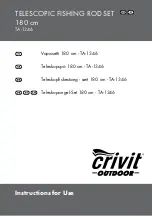
26
The forward lead block is fitted so that the
furling line is straight when it exits the line
guide fitting.
Slacken the locking screw
a little. (See
fig. 4.3.d.) Align the eye of the line guide to
the first lead block as shown in the diagram
above. Tighten the locking screw.
The line should be led aft to the cockpit via the lead blocks included in the Furlex package. The lead
blocks are mounted on stanchions and the pulpit. See fig. 6.4.a-6.4.f.
The final turning block by the cockpit is not
included in the Furlex kit. This needs to be
matched individually to each boat depending
on the attachment points, the line arrange-
ment chosen and possibly also the type of
other blocks on the boat. We recommend a
swivel block which is free to self align.
The maximum working load of the block
should not be less than 3000 N (675lb).
It must be possible to belay the furling line securely. A block with a Cam-cleat works
well when securing a reef, but is unreliable if the boat is left unattended.
The line should then be secured on a normal cleat for safety reasons. We recommend a
single turning block in combination with a cleat.
If the furling line is accidentally released, the sail may unfurl and flap unchecked in
strong winds. It could be damaged irreparably !
Fig. 6.3.a
Fig. 6.3.b
Fig. 6.3.c
6.3 Routing of the furling line
















































